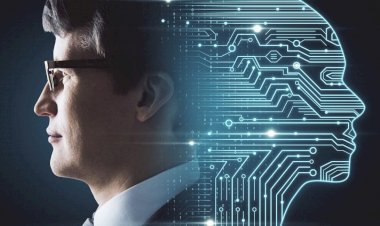[ Explained Simply ] AI, Machine Learning, Deep Learning
As “Artificial Intelligence” become more intelligent and prevalent, there’s a natural fear that grows within us.
![[ Explained Simply ] AI, Machine Learning, Deep Learning](http://geeksourcecodes.com/uploads/images/image_750x_5df0ba2bd2bb4.jpg)
People talk about “Artificial Intelligence” as if it’s still in the future. Today, in 2019, Artificial Intelligence is already proliferating in our lives.
READ ALSO: 10 BEST Mobile Apps That Must Have Given You A Productivity Boost in 2019.
As “Artificial Intelligence” become more intelligent and prevalent, there’s a natural fear that grows within us. We can fear the dystopia brought on by not implementing AI correctly in our society. We can fear that AI will replace all of our jobs. We can fear our addictions to these technologies.
What is Artificial Intelligence?
Artificial Intelligence is just as the word implies, the intelligence is artificial, programmed by humans to perform human activities. This artificial intelligence is incorporated into computer systems to create AI Systems that ultimately functions as units of “thinking machines”.
- General AI Systems can solve problems intelligently. (Example: AI-powered Stock Trading System)
- Narrow AI Systems can perform specific tasks very well. (Example: AI-powered Manufacturing Arm)
Intentionality — Humans design AI systems with the intention of making decisions from historical or real-time data or both. These AI systems contain predetermined responses.
Intelligence — AI systems often incorporate machine learning, deep learning, and data analytics with artificial intelligence that enable intelligent decision making. This intelligence is not human intelligence. It’s the machine’s best approximation to human intelligence.
Adaptability — AI systems have the ability to learn and adapt as they compile information and make decisions. As AI systems learn from real-time data, AI systems can refine their decision-making capabilities to improve the outcome.
READ ALSO: Types of Artificial intelligence
Artificial Intelligence, Machine Learning, Deep Learning
Machine Learning — It is an application of artificial intelligence that provides the AI System with the ability to automatically learn from the environment and applies that learning to make better decisions. There are a variety of algorithms that Machine Learning uses to iteratively learn, describe and improve data in order to predict better outcomes. These algorithms use statistical techniques to spot patterns and then perform actions on these patterns.
Deep Learning — It is the next generation of Machine Learning. It’s a subset of Machine Learning. Deep Learning models can make their own predictions entirely independent of humans. Machine Learning models of the past still need human intervention in many cases to arrive at the optimal outcome. Deep Learning models use artificial neural networks. The design of this network is inspired by the biological neural network of the human brain. It analyzes data with a logical structure similar to how a human would draw conclusions.
Real Life Applications
AI is best suited to solve certain problems over others. More often than not, AI is best suited to perform certain steps at solving a problem while leaving the rest to a human being. For instance, AI enabled chatbots might be able to follow up with employees about their projects to receive updates on statuses, but, managers still have to build teams, inspire teams and steer the teams toward the right directions.
Problems best suited for AI to solve:
- Repetitive Tasks — Manual tasks that follow logical steps to lead to a conclusion. (Example: packaging goods to be ready for delivery at a warehouse)
- Data Intensive Tasks — Tasks involving analyzing large amounts of data looking for patterns and anomaly. (Example: detection of fraud from financial records.)
- Super Human Tasks — Tasks that require superhuman capabilities and speaks to the limitations of human sensory skills and fine motor skills. (Example: Robot surgeon can use the most precise movements to perform non-invasive surgeries. Finely tuned computer vision can spot tumors on an MRI when human eyes can not see it.)
Future #AI 4@SpirosMargaris @JimMarous @Xbond49 @jblefevre60 @ahier @psb_dc @guzmand @TheRudinGroup @leimer @TopCyberNews @ipfconline1 @pierrepinna @missmetaverse @mclynd @jaypalter @AghiathChbib#DeepLearning #MachineLearning #Fintech #DataScience #5G https://t.co/MCoxqAf7uu pic.twitter.com/GNLJ635aHX
— AI (@DeepLearn007) December 10, 2019
Messy data pipelines, complicated deployment scenarios. Thank goodness the TensorFlow: Data and Deployment Specialization will teach you how to navigate both. Announcing course titles and launch dates! pic.twitter.com/lYLDR67Xtn
— deeplearning.ai (@deeplearningai_) November 27, 2019
The US has build the world’s fastest #supercomputer that can process 200,000 trillion calculations per second #ArtificialIntelligence #automation #Computing #MI #ML #Tech #Cooltech #MachineLearning @MargaretSiegien @mvollmer1 @Nicochan33 @Julez_Norton
— Mario Pawlowski (@PawlowskiMario) December 11, 2019
pic.twitter.com/FRUB3I7wfS
Explaining #AI : Machine Learning vs Deep Learning#MachineLearning #DeepLearning #Marketing #ML #DL #martech #tech https://t.co/ykO8tWfIhR pic.twitter.com/rgPnav8lrS
— AI (@DeepLearn007) October 5, 2017
#AI can save lives while #Swimming by detecting probability of #drowning#ArtificialIntelligence #ML #MachineLearning #DeepLearning #tech #science #video pic.twitter.com/eOGpACpd4o
— Aleksandra Protic (@Aleksan03565134) December 10, 2019
SUBSCRIBE TO OUR YOUTUBE CHANNEL BELOW TO WATCH MORE VIDEOS


























